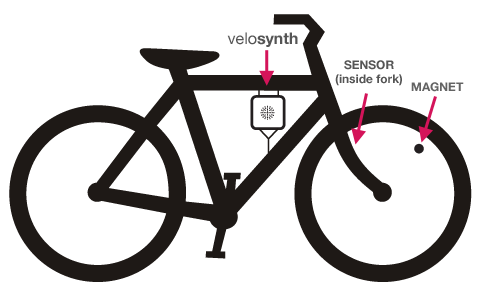velosynth release#001 from velosynth on Vimeo.
Bicycle transport is cheap, environmentally sound, and quiet – a little too quiet. Since bikes don’t make noise, it can be difficult to hear them coming. And since a bicyclist should be focused on the road, any visual feedback to the bicyclist is potentially distracting. What’s the solution? How about a box that easily straps to a bike and makes sounds? Sounds can provide feedback to pedestrians, fellow cyclists, and other people sharing the road. They can also make distraction-free sonification of data the cyclist might want, as opposed to requiring that a rider take their eyes off the road to read a display. Using network features, you can even communicate amongst a crowd of cyclists.

The Velosynth is an open-source (Creative Commons-licensed), hackable sound gadget that attaches to a bike. To measure speed and acceleration (essential for making vroom-vroom-style sounds when the bike is in motion), the device uses a magnet and sensor combination on the wheel. There’s also a three-axis accelerometer, built-in amp, and Arduino-compatible brain. You can buy the device as a US$100 kit or get a pre-assembled device.
EFFALO, despite the silly and tongue-in-cheek video, are a serious “hyperlocal” maker of new designs to explore interaction, environments, and DIY hardware and fabrication. The group is based in Portland, Oregon, and includes monome community regular Michael Felix, aka “%.”
The EFFALO crew aren’t just looking for publicity, though; they hope that they can get help, including bright ideas for how to make this project useful, from hackers, designers, and musicians. The Kickstarter project they’ve started isn’t just a beg for money, either – it’s effectively a preorder page for kits for hackers or pre-built devices for non-hackers. A few kits are left, though I expect they won’t last very long after this post.
The potential of a bike-mounted synth also shows how transformative mobile sound synthesis can be. Sure, today’s digital synths aren’t far removed from those available twenty or thirty years ago. But whereas early synths required big budgets and big rooms, making them useful to sound studios or academic research facilities but not much else, sound today can be a commodity. Just as with the display, mobile sound synthesis may have uses far beyond just making unusual music. (That’s why yesterday’s mention of batteries wasn’t just a random post.)
Case in point: Velosynth isn’t alone. Electric cars face a similar challenge; their silent operation means that producing synthesized sound becomes a safety feature. That issue appeared just last week on the superb design blog core77:
An update on “vroom tones” for electric cars
Of course, unlike conventional motors, it’s possible to actually design the sounds transport methods make. That can mean producing sounds that are less disturbing to neighbors and that are simultaneously more effective for localizing where the vehicle is relative to the listener. Another project to watch: the makers of the upcoming OP-1 synth by Teenage Engineering have also engineered an electric bicycle, meaning some sort of interaction between the bike and the synth is possible.
All the details on Velosynth:
http://velosynth.com/
For more tunes by %, check out virb.com/owneroperator
Previous posts on the relationship between bikes and electronic music:
Music Sequencing as Bicycle Wheels, Rubik’s Cubes at Fest in Argentina
Maker Faire: Giant Bicycle-Part DJ Looping Reel-to-Reel Tape Deck
Music for Bicycles: Ensembles, Symphonies, and Bikelophones
Nutcracker Suite Played Exclusively on Bicycle Parts
More Musical Mayhem, Instant Art with Bicycles